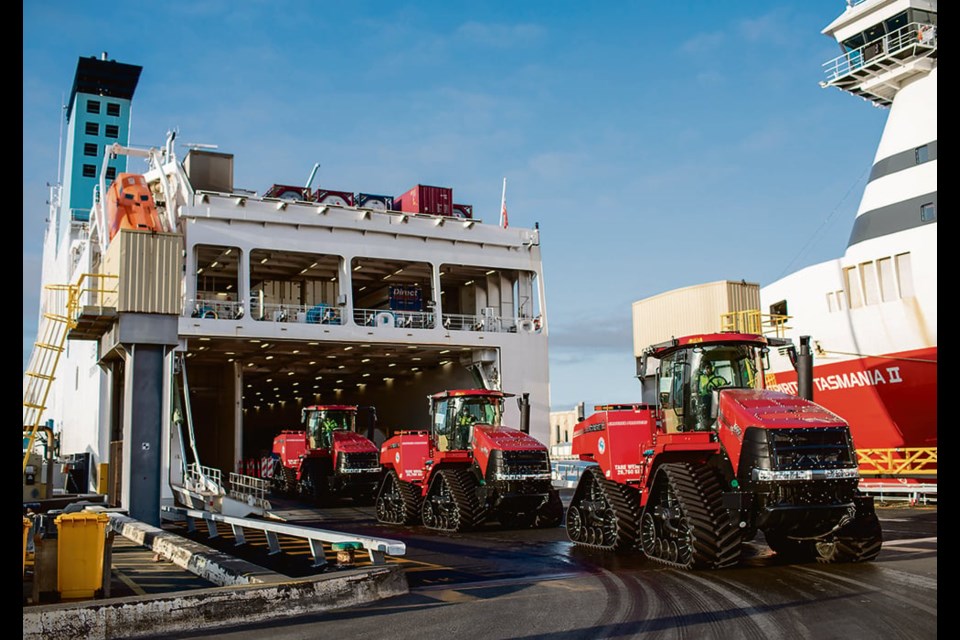WESTERN PRODUCER — Three Quadtrac tractors modified for extreme cold operations are being delivered to the Australian government for service in Antarctica.
The Australian Antarctic Division will use the tractors for general sled towing, heavy vehicle recovery, cargo transport from Casey to Wilkins and maintenance on the Wilkins Blue Ice Runway by pulling a 90-tonne roller and scraper.
Tom Curley, global product manager for Case IH Steiger, said the four-track design of Steiger tractors made the platform ideal for many applications besides farming, from snow removal at airports to use as minesweepers, since the 1996 commercial launch of the Case IH Quadtrac.
“From the beginning of when we started building Quadtrac there was always this interest from different operators and farmers across the world to use the tractor in ways that we weren’t necessarily expecting, and this definitely being one of them,” Curley said.
“The combination of our unique track system, the articulated capabilities of our tractor and the oscillation of the tracks and the vehicle itself allows the undercarriages to consistently apply traction to the ground in all kinds of conditions, especially in this case on ice.
“We designed a standard tractor for an extreme cold weather climate, knowing that we’re doing snow removal in places like northern Saskatchewan and northern Alberta. So, we know what it takes to make the standard tractors work at cold temperatures.”
The Australian Antarctic Division asked Case IH in 2021 if it wanted to submit a bid to build the three tractors.
Curley said Case IH was asked to bid on the contract because Quadtracs have been successfully used in various extreme cold climate operations, in both the Arctic and Antarctica for 20 years.
The new tractors were built in early 2022, and extensive updates for cold weather operations were made in the summer.
“We ask our engineering team to fully review the tractor from the ground up, starting with everything from the tracks all the way up to the cab. There were a large number of modifications,” Curley said.
“The tracks are specially built for the cold weather application. They made several modifications to our undercarriages to make sure that they also were built for the -40 operating temperatures.”
The Antarctic-rated rubber tracks are a proprietary design that Case IH worked on with a track manufacturer.
“They’ve actually built these Antarctic-rated tracks for this special application as a partner in the project for 20 plus years,” Curley said.
“They (tracks) have different rubber compounds that are strategically placed in the tracks for flexibility in the colder temperatures while still maintaining traction and reliability for higher use.”
There were also extensive modifications to the tractors beyond the tracks and undercarriage, including a review of every hose on the tractor, with many being switched out.
Curley said many of the hoses on Quadtracs already have extreme cold weather ratings, but hoses that experience any movement received extra attention.
“At low temperatures the stiffness of the hose can come into play and affect reliability over time. So, anything that was potentially being moved on the tractor during operation was an important focus for us to make sure that they were going to maintain flexibility even at -40 plus degrees.”
Likely the most apparent change to the tractor was the modifications made to the hood to fully enclose the engine to ensure it would stay warm in the extreme temperatures.
Larger fuel tanks were added that tripled the tractor’s fuel holding capacity for long journeys across the ice.
Heavy duty heaters were also installed to help thaw the tractors before being fired up.
“We have both electric and diesel fired auxiliary heaters that were installed to heat the engine, transmission and the hydraulic system prior to being started to maintain a reasonable operating temperature for them, and to warm them up prior to being started after they sit for an extended period of time,” Curley said.
Cab modifications were made to accommodate the auxiliary heaters as well as circulation fans and an additional sunshade for operator comfort.
However, Curley said the operator’s experience is similar to a typical Quadtrac, including the AFS Connect operating system.

